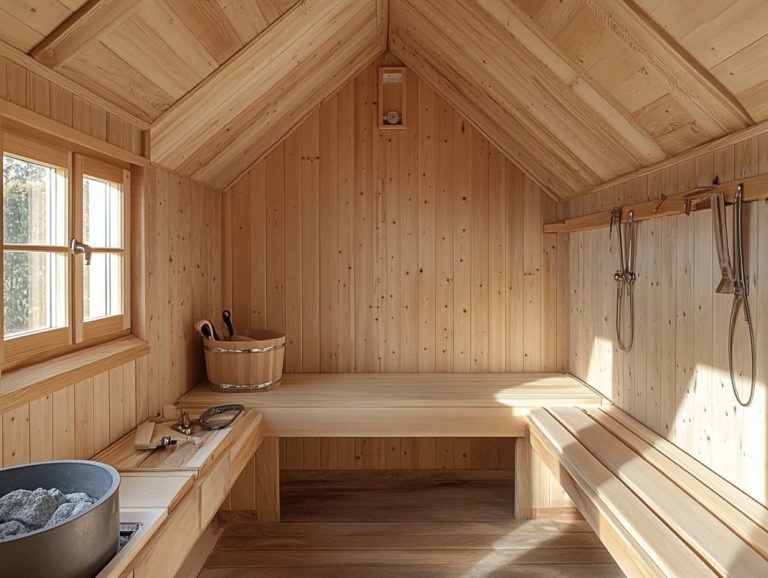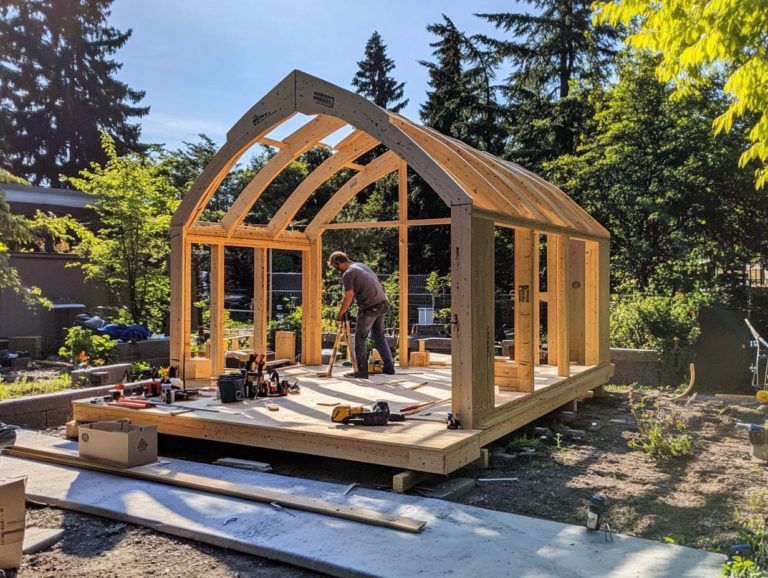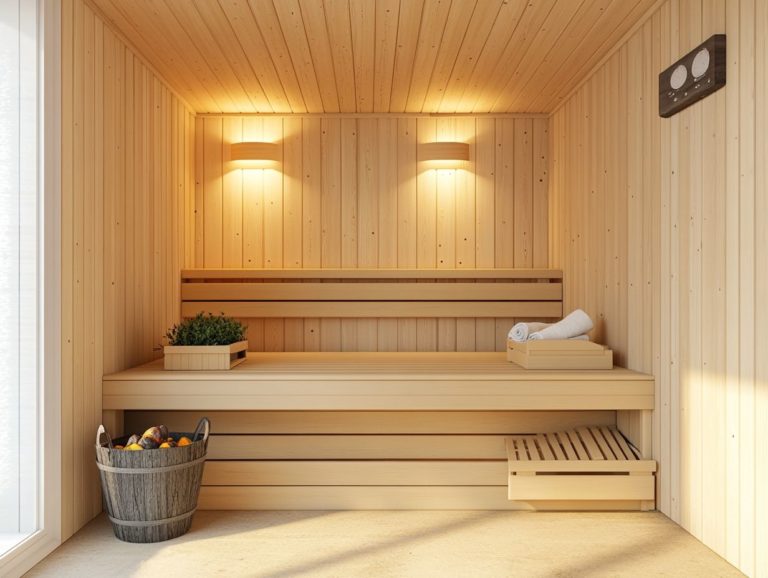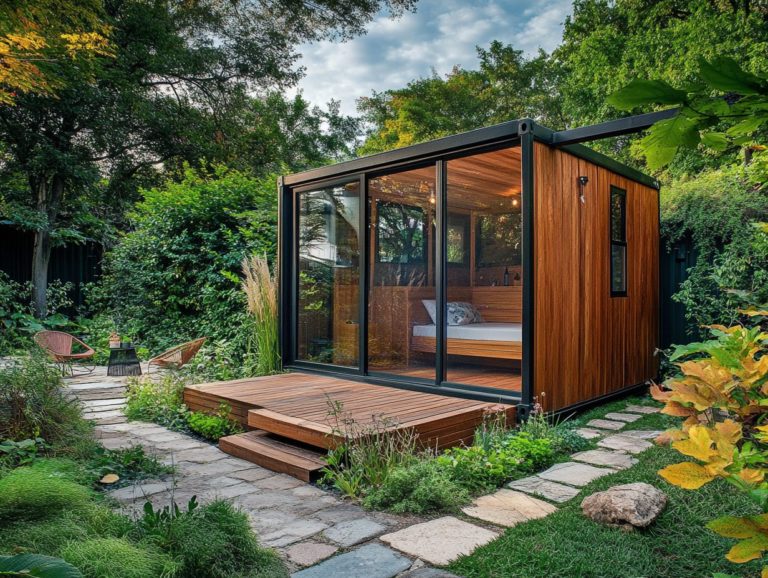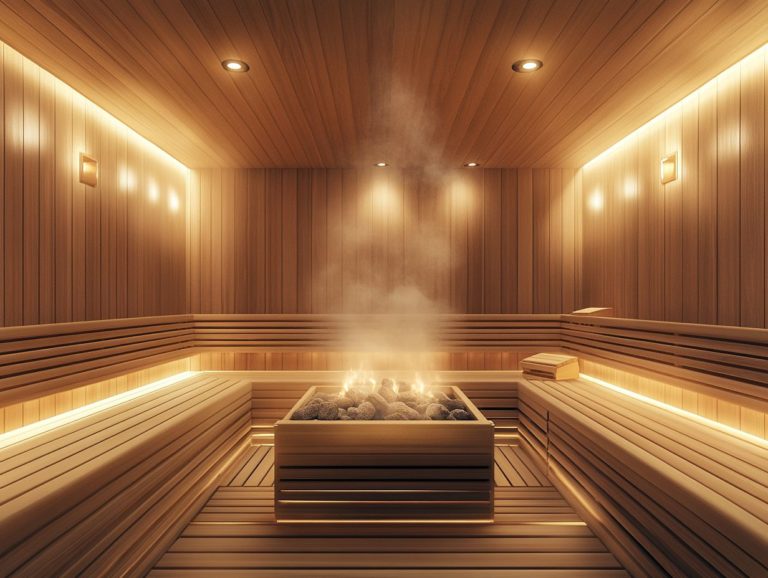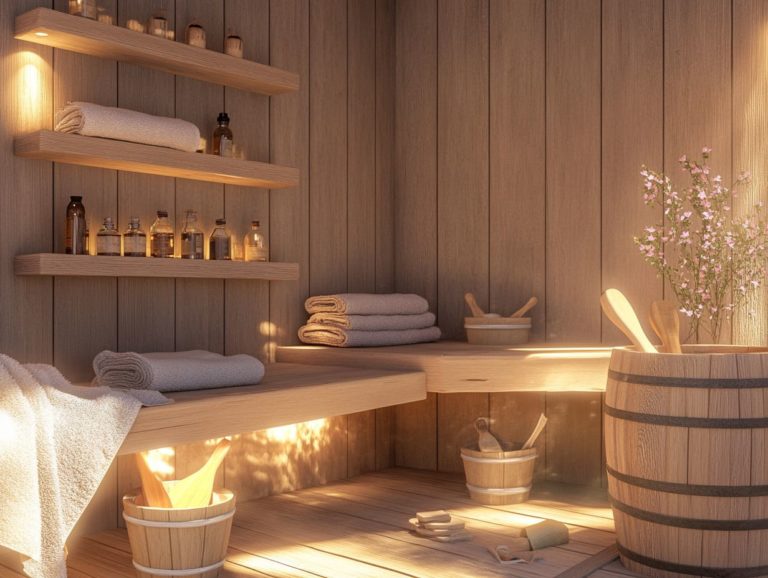“DIY Sauna Flooring Options: Pros and Cons”
Creating a DIY sauna at home is an exhilarating endeavor! Selecting the right flooring is crucial for both functionality and aesthetics.
This guide delves into various DIY sauna flooring options, showcasing their advantages, including potential cost savings and the freedom to customize your space.
You will compare materials like wood, vinyl, ceramic tile, and concrete while weighing the pros and cons of each.
Think about your budget, how much maintenance you want, and how well the material handles heat and moisture. This way, you can ensure a well-informed decision for your personal retreat.
Contents
- Key Takeaways:
- Benefits of DIY Sauna Flooring
- Types of DIY Sauna Flooring
- Pros and Cons of Each Flooring Option
- Factors to Consider When Choosing DIY Sauna Flooring
- Frequently Asked Questions
- What are the benefits of DIY sauna flooring options?
- What are some popular DIY sauna flooring options?
- What are the pros and cons of using cedar planks for sauna flooring?
- Are interlocking rubber tiles a good option for DIY sauna flooring?
- What are the benefits of using vinyl flooring for a DIY sauna?
- What are the cons of using vinyl flooring for a DIY sauna?
Key Takeaways:
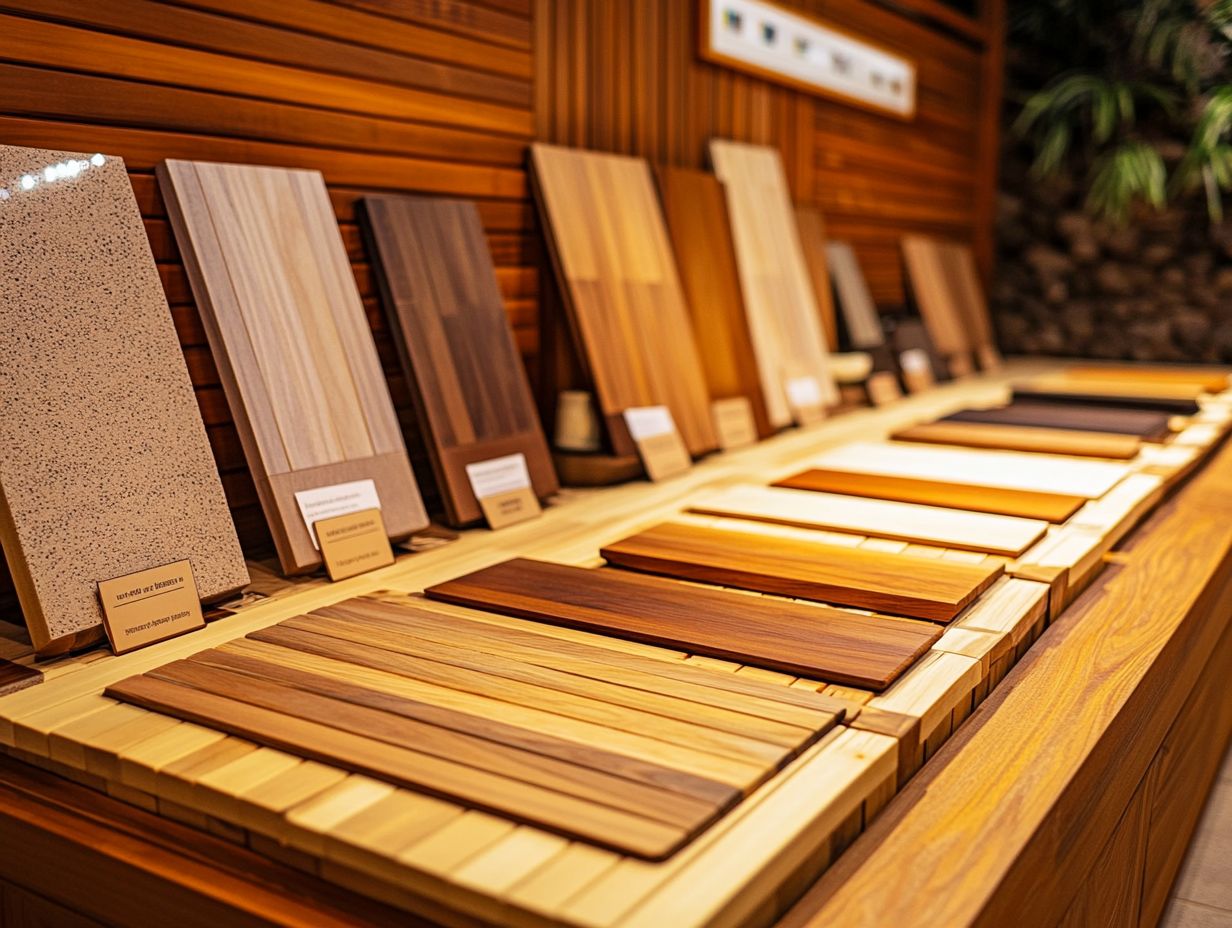
- Save money and add a personal touch with DIY sauna flooring! Consider incorporating Finnish elements for authenticity.
- When choosing flooring, consider your budget, maintenance needs, and how well the material resists heat and moisture.
- Wood, vinyl, ceramic tile, and concrete each have pros and cons for sauna flooring.
What is DIY Sauna Flooring?
DIY sauna flooring encompasses a range of options designed to create your personalized sauna experience at home. It’s essential to focus on materials that provide warmth to keep you comfortable, moisture resistance, and visual appeal, whether you choose a wood-burning sauna or an electric heater.
Choose the right building materials think cedar wood or ceramic tiles while keeping in mind the specific needs of your indoor or outdoor sauna. This will help transform it into your personal oasis. Understanding the insulation and maintenance needs is crucial for establishing a long-lasting sauna environment that promotes relaxation and hygiene!
As you explore flooring options for your DIY sauna, consider materials like bamboo, which offers excellent thermal properties and brings a modern touch to the space. Each material has unique qualities that can impact both ambiance and functionality.
For example, cedar wood is popular due to its natural moisture resistance and delightful aroma, creating a calming atmosphere. Selecting flooring that effectively retains heat can enhance the health benefits associated with saunas, such as improved circulation and stress relief, making your DIY project even more rewarding.
In the end, striking the right balance between functionality and aesthetics can significantly elevate your overall sauna experience!
Benefits of DIY Sauna Flooring
The benefits of DIY sauna flooring are extensive! You get a blend of cost savings, customization, and enhanced health advantages that make it an enticing option for those looking to craft their perfect relaxation sanctuary.
By choosing the DIY route, you have the freedom to select flooring that aligns with your personal aesthetic while ensuring it meets durability and moisture resistance standards essential for preserving the integrity and hygiene of your sauna.
You can also tailor your flooring to incorporate features that enhance thermal comfort, such as a non-slip texture, guaranteeing an enjoyable and soothing sauna experience.
Cost Savings and Customization
One of the primary advantages of crafting your own DIY sauna flooring is the potential for substantial cost savings combined with extensive customization options! This enables you to tailor your sauna experience precisely to your preferences and budget.
By choosing materials wisely like cedar wood for its durability and aesthetic appeal or cost-effective options such as vinyl or concrete you can create an inviting space without breaking the bank. Customizing the layout and design not only enhances the sauna’s visual appeal but also boosts functionality and thermal comfort.
As a DIY enthusiast, you have the freedom to experiment with various design elements, such as integrated benches or unique lighting solutions, which can elevate the overall atmosphere of your sauna. Unlike pre-manufactured kits, a DIY approach opens the door to innovation, ensuring your sauna becomes more than just a place to relax; it transforms into a personalized retreat!
Incorporating reclaimed wood or eco-friendly materials can further reduce costs while promoting environmental sustainability! This makes your DIY sauna not only budget-friendly but also a fulfilling endeavor on both personal and ethical levels.
Ready to create your dream sauna? Let’s get started!
Types of DIY Sauna Flooring
When exploring DIY sauna flooring, you ll discover many options, each offering unique advantages. From the classic charm of traditional woods like cedar and hemlock to the modern appeal of concrete, the choices are abundant.
Cedar and hemlock wood are popular selections, known for their visual charm and excellent heat retention. Conversely, concrete flooring is remarkably durable and moisture-resistant, making it a great choice for both indoor and outdoor saunas.
Understanding the unique qualities of each flooring type is vital for finding the right fit for your sauna’s design and function, especially when considering your heating and power sources.
Comparison of Materials
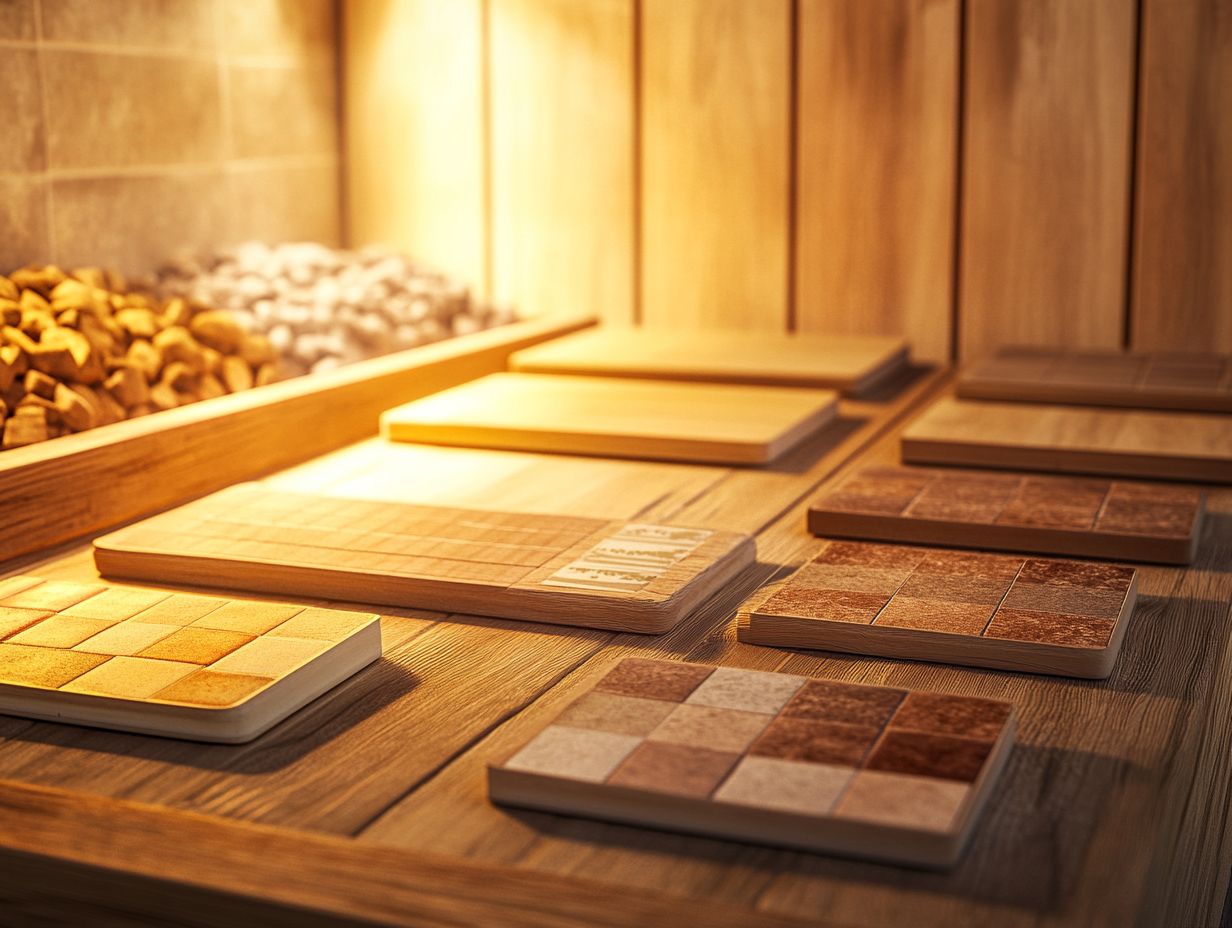
When comparing materials for your DIY sauna flooring, evaluating their thermal properties, durability, and visual appeal is crucial. This ensures that your sauna environment is comfortable and looks good, whether you choose a wood-burning sauna or an electric heater.
Materials like cedar wood are often preferred for their delightful aroma and great insulation. On the other hand, options such as ceramic tiles or vinyl flooring provide moisture resistance and easy maintenance. Making an informed choice can significantly enhance your sauna experience.
Consider wood options like hemlock and spruce, which offer excellent heat retention for a relaxing atmosphere. While wood flooring provides a classic, warm look, it’s important to consider how these materials handle the high humidity typical in a sauna.
Ceramic and porcelain tiles are highly moisture-resistant, helping to reduce mold growth, though they may feel cooler underfoot. Remember, these choices might require more effort for installation and maintenance, particularly in ensuring safety and minimizing slip hazards.
Your selection should strike a balance between comfort and practicality, enhancing both the aesthetic and your overall wellness experience, while ensuring cleanliness throughout the sauna.
Pros and Cons of Each Flooring Option
Understanding the pros and cons of each flooring option for your DIY sauna is essential for making an informed decision. This helps balance durability, maintenance, and looks, ensuring your sauna remains a personal oasis for relaxation.
Wood flooring exudes warmth and charm, but it requires regular upkeep to maintain its quality. In contrast, materials like vinyl or concrete offer durability and easy care, though they may lack the traditional sauna ambiance that many people desire.
By weighing these factors carefully, you can choose the perfect flooring that meets your needs and enhances your sanctuary, utilizing cost-effective and eco-friendly materials when possible.
Wood Flooring
Wood flooring is a stylish choice for your DIY sauna, thanks to its natural beauty, impressive heat retention, and calming aroma. Cedar and hemlock wood are the top choices for this purpose.
These woods create a warm atmosphere and offer moisture resistance and durability, making them ideal for the high temperatures and humidity typical in saunas. Remember, regular maintenance is essential for preserving their aesthetic and functional qualities.
The insulation properties of cedar and hemlock keep your sauna comfortable while reducing heat loss a crucial factor for efficiency. Both woods naturally resist mold and mildew, enhancing hygiene and longevity.
Hemlock, with its lighter hue and fine grain, adds subtle elegance, while cedar’s rich tones and aromatic scent provide a sensory experience that elevates relaxation.
Caring for these materials is simple; often, basic cleaning methods are enough to maintain their beauty. By choosing cedar or hemlock flooring, you can create an inviting space that is stunning and functional.
Vinyl Flooring
Vinyl flooring presents an enticing choice for your DIY sauna, combining cost-effectiveness with outstanding moisture resistance just what you need in a humid environment. This type of flooring not only features a non-slip texture for added safety but also comes in a variety of designs, enabling you to achieve your desired aesthetic without sacrificing functionality or comfort.
It s easy to clean and maintain. This ensures a hygienic sauna experience that lasts for years.
However, while the advantages are compelling, it s wise to also consider the potential drawbacks. Even though vinyl flooring is moisture-resistant, prolonged exposure to extreme heat could affect its durability over time, possibly leading to warping or discoloration, which is essential to keep in mind when planning your sauna’s heating source.
Maintenance is minimal, yet it s worth noting that it may be prone to scratches or dents from heavy items, which could compromise its visual allure. Weighing these pros and cons is essential for anyone looking to create a sauna space that is not only visually stunning but also safe and built to last.
Ceramic Tile Flooring
Ceramic tile flooring stands out as a remarkably durable choice for DIY saunas, offering exceptional waterproof features that can easily handle the high humidity and temperatures typical in these environments. Its non-slip texture enhances safety, allowing you to relax without the anxiety of slipping.
With a vast array of colors and designs available, ceramic tiles improve the look of your sauna, allowing you to express your personal style.
Ceramic tiles also offer great hygiene benefits. Their smooth surfaces make it hard for mold and bacteria to grow, ensuring a cleaner environment for your relaxation.
Maintenance is generally a breeze just regular sweeping and the occasional mop will keep it looking fresh. While there is a potential for chips or cracks, this is a manageable concern.
When installed and maintained properly, the longevity of ceramic flooring far exceeds these minor drawbacks, making it a wise investment for anyone looking to create a stunning and functional Finnish sauna retreat.
Concrete Flooring

Looking for a robust and cost-effective solution? Concrete flooring is the way to go! It delivers exceptional durability and thermal comfort, essential for creating that perfect sauna environment. While it may have an industrial vibe, concrete can be enhanced with various aesthetic finishes, allowing you to personalize it to match your taste.
Its moisture resistance and low maintenance needs make it a practical choice, whether for indoor sauna or outdoor sauna.
You’re also benefiting from its inherent safety features, which help minimize the risk of slips and falls, particularly in wet conditions. The functionality of concrete extends to its remarkable ability to withstand high temperatures and humidity without compromising structural integrity, making it an ideal partner for the intense heat of a sauna.
You ll appreciate the ease of cleaning and upkeep, reducing the hassle often associated with other flooring materials, enhancing your sauna experience.
With options like stamped patterns and colored stains, concrete can evolve into an elegant surface that enhances the tranquil ambiance of your sauna, seamlessly balancing aesthetics with style.
Factors to Consider When Choosing DIY Sauna Flooring
When selecting DIY sauna flooring, you ll want to consider several critical factors: your budget, maintenance requirements, insulation properties, and the aesthetic that will help you create a welcoming sauna environment, ensuring optimal thermal properties.
By carefully analyzing these elements, you can make a well-rounded decision that meets both your functional needs and elevates your overall sauna experience. Prioritizing insulation and durability will allow you to craft a safe and comfortable space tailored to your personal preferences and intended sauna usage.
Choose the best flooring for your DIY sauna and enjoy the perfect retreat!
Budget and Maintenance
Prioritizing your budget and maintenance is essential when choosing DIY sauna flooring. These elements significantly impact both your initial investment and the long-term enjoyment of your sauna experience. Consider cost-effective materials that combine durability with minimal upkeep. This ensures your sauna remains a soothing retreat without straining your finances.
It s crucial to assess the maintenance requirements of each material to create a hygienic environment that enhances health benefits.
For example, vinyl flooring is a water-resistant, budget-friendly option that thrives in the moisture-heavy atmosphere of a sauna. It remains a popular choice among flooring options. With just regular cleaning, it stays looking sharp and inviting.
Bamboo is an eco-friendly option. It not only elevates the aesthetic but also resists warping.
By considering the frequency of care needed, you can select the right flooring material. This choice enables you to maintain your sauna effortlessly while enjoying an economical choice that enhances your personal oasis.
Resistance to Heat and Moisture
The resistance to heat and moisture is a critical factor when selecting flooring for your DIY sauna. These elements directly impact the sauna’s functionality and durability.
Prioritizing flooring materials with high heat and moisture resistance enhances the overall sauna experience. Options like ceramic tiles or specially treated hardwood are excellent choices. They effectively manage fluctuating temperatures while minimizing the risk of distortion or damage from excess moisture.
Don t overlook materials such as vinyl or composite flooring, known for their resilience. They provide a safe, comfortable surface that withstands intense heat and humidity without sacrificing aesthetics.
Carefully considering the heat and temperature response of your flooring can create a rewarding sauna environment. This maximizes both safety and enjoyment, allowing for a complete sauna experience.

Frequently Asked Questions
What are the benefits of DIY sauna flooring options?
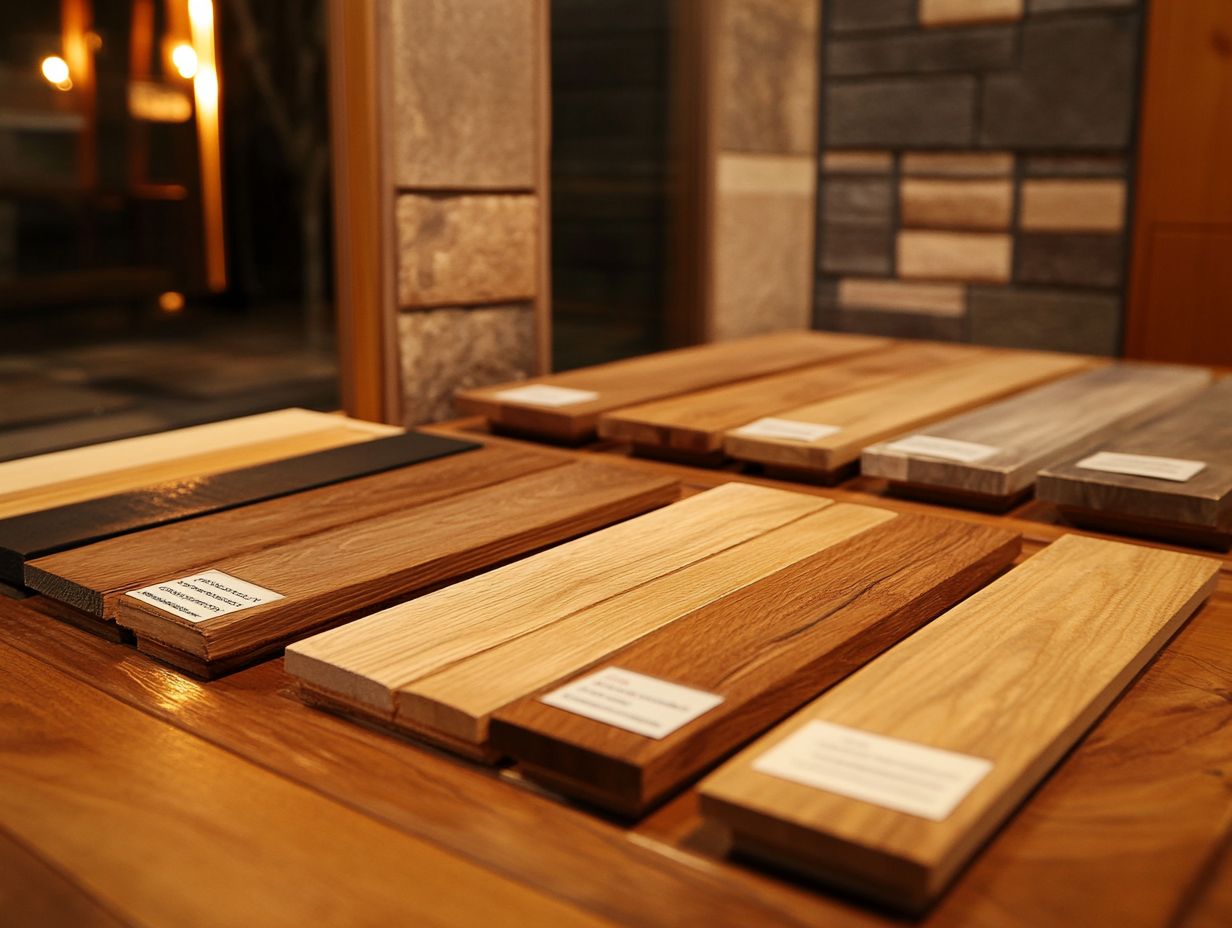
DIY sauna flooring options offer flexibility and cost savings. You have control over the materials and installation process.
What are some popular DIY sauna flooring options?
Some popular DIY sauna flooring options include cedar wood planks, interlocking rubber tiles, and vinyl flooring. All of these are known for their moisture resistance and aesthetic appeal.
What are the pros and cons of using cedar planks for sauna flooring?
Pros of using cedar wood planks include their natural resistance to moisture and durability. This makes them a traditional choice for a wood-burning sauna. However, they can be more expensive and require regular maintenance.
Are interlocking rubber tiles a good option for DIY sauna flooring?
Interlocking rubber tiles are a great option for DIY sauna flooring. They are easy to install, water-resistant, and provide a comfortable, slip-resistant surface that contributes to safety.
What are the benefits of using vinyl flooring for a DIY sauna?
Choose vinyl flooring for a cost-effective solution. It is easy to install and maintain, water-resistant, and provides a smooth, comfortable surface for sauna use.
What are the cons of using vinyl flooring for a DIY sauna?
While vinyl flooring is a popular choice, it can emit harmful chemicals when exposed to high heat. This emphasizes the importance of selecting safe building materials. Research the specific type of vinyl flooring to ensure it is safe for sauna use, particularly regarding its energy efficiency and impact on health.

